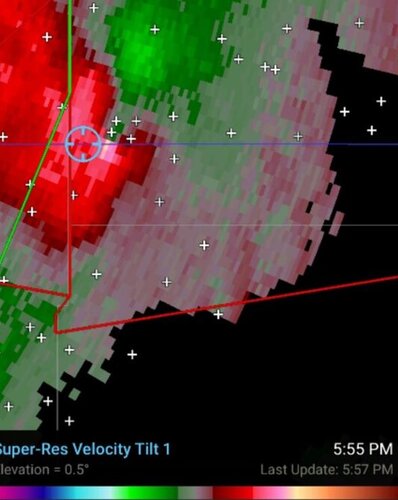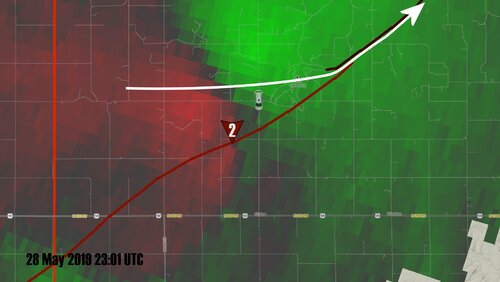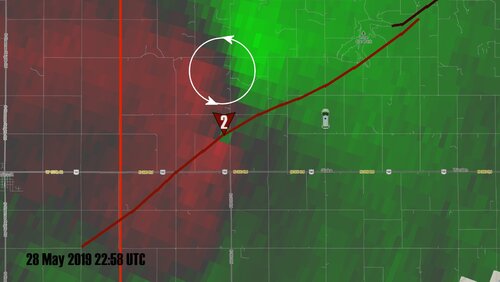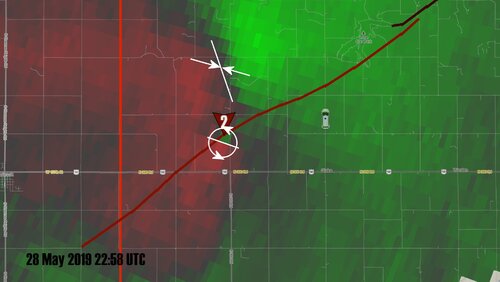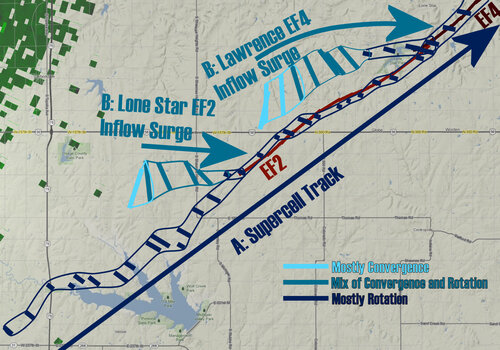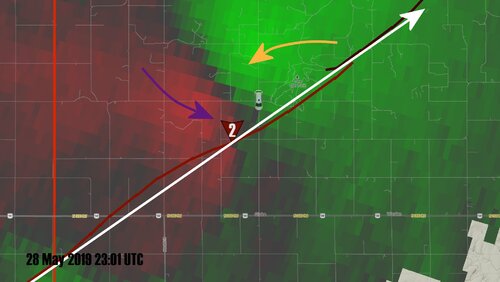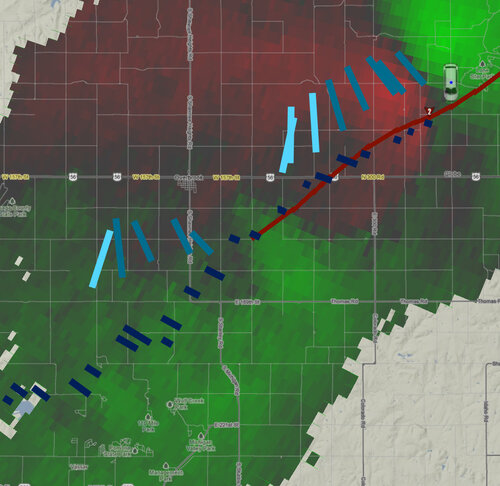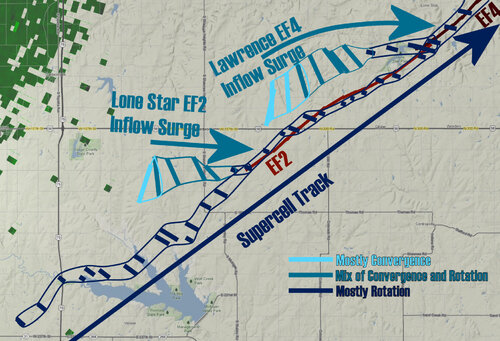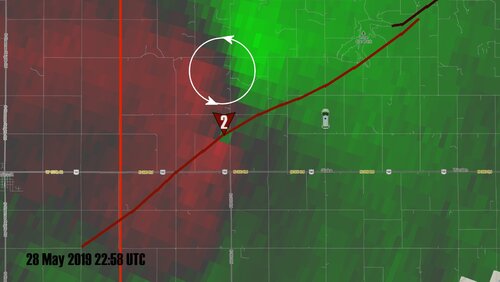Alex, have you learned anything on the extensive article posted above that provides expert analysis? You're not being honest here and nobody is making any opinion based only on a short video. There's a lot of evidence floating around online, not just radar data. You better tell those NWS meteorologists that they aren't so special "sitting behind their screens" too. Sometimes radar data gives you enough clues to make a confident decision, only if you have that expertise, I guess? I'm not sure what you're trying to do here but I'll stop you in your tracks with your own words... you mention "every storm" "massively HP" ... that's what your fellow meteorologists and storm chasers are telling you... keep your distance. Don't even play around with these storms, especially if you have van loads of people. I wonder how many times all of us need to say this before the denial and arguing stops? No legitimate meteorologist should be defending getting into a Bear's Cage in an HP supercell situation with a van load of people. I say that, but then here you are with the old "you weren't there."
You have a PhD in Atmo Science? In science, many times a scientist can render an opinion based on the body of evidence (which is overwhelming in this case and not based on a single 6-minute video but a plethora of evidence including their own statements, video, radar data, damage path, witnesses, etc.) without being there. Examples of this would include what climate was like 1,000 years ago somewhere on Earth. You weren't there? No problem, we have evidence and if you know how to interpret that evidence, you can render an educated confident opinion. Another includes the great example of a doctor coming in and testifying about a death in a court case. He or she wasn't there but can tell you how someone died based on the body evidence and their expertise. Note: BODY. Not a single 6-minute video as you wrongfully suggested everyone's analysis is based upon.....
At this point, I see no further reason to comment on the analysis that is already out there and obvious. There still seems to be a small handful of people on the wrong side of science, safety, and common sense. "Roger is a good guy" is like a broken record. We're not talking about Roger's people skills or how nice he is to hang out with according to his supporters. We're talking about the radar data, obvious, Bear's Cage, the event that lead to 12 injuries (some allegedly serious), safety, damage path, past events, witnesses, their own video, tour participants, etc.
- We were stuck in traffic in a town of 50,000 people, moving at ~35 mph moving from red light to red light, while what was very clearly a violent tornado producing mesocyclone began to move overhead. I'm not exactly sure what you think you'd do in that situation Anthony, but I promise you your reaction would likely be similar
You can't promise me that because I wouldn't put myself in that situation WITH vans loaded full of people. I don't know what kind of experience you have but this is a really bad situation you shouldn't get yourself into with vans packed full of people in an HP situation. This is what we're trying to say. You didn't know the population or anything about an area you were chasing in ahead of time? Plan much? You don't know the speed of the storms ahead of time? You don't expect or plan for changes? You don't plan on escape routes? Vans packed full of people? I would never put myself in that situation.
If I ran a tour company and had 2 vans flip with a dozen people sent to the hospital with varying injuries, I would take some time to stop and take in what happened for a few weeks, take some time off, reflect on myself and the situation, take responsibility, learn from my mistakes, and move on to something better. That's not what appears to be happening in this situation, at least publicly in clear view. And these few people coming by thinking they are doing Roger a service by attacking the obvious, downplaying, deflecting, remaining in denial, and repeating like a parrot that "Roger is a good guy" aren't helping anything IMO.
As people have said before, I too hope you and Roger or whoever you represent learned from these "alleged" mistakes. Getting too close could have killed you all. If/when that happens, it will have an impact on the entire chase community. I really hope everyone learned from this and that the talk here pressures tour operators to increase distance/awareness and just don't play around with HP supercells anymore. People will give you the benefit of the doubt in general, but there's just too much happening in this case to downplay it or pass it off as nothing.
Alex, are you serious that after this entire thread, articles, videos, witnesses, damage paths, analysis, and more than one event you can't possibly fathom why Roger's "safety" record might be challenged? You can't understand why nearly every meteorologist practicing right now said driving into the Bear's Cage with vans packed full of people is......... bad? Seems a bit off.
You also seem to indicate this was a surprise during Joplin but then you indicated supercells existed "very HP". Was there a tornado watch? "Be alert to rapidly changing weather conditions. Severe storms can and do produce tornadoes with little to no warning." This used to be something taught to grade school kids since the 1980s. It was taught in every severe weather course as well. You would think someone with a degree in meteorology would have this thought in the back of their head more so when they are part of a tour with loads of people in vans getting close to something like this, right?
Based on numerous videos I've seen, there was one in particular where the van was beeping it's horn and someone said don't stop for anything. They were close to another HP supercell tornado I believe, vans loaded full of people. Why the need to beep a horn and say don't stop for anything if this is safe? The context is very interesting here. In rainy conditions during a tornado warning, it's not safe sometimes to try and rush through traffic that is appropreately moving slower for the inclement weather conditions (slick, less visibility, etc.). Common sense.
Gist: I would not put myself in that situation, it was unnecessary. There was ample warning as to this event before the vans drove into the tornado. This is not the first close call. The fact that the vans rolled and injuries happened means it was time for this discussion. I have been chasing for decades and would never do this with cars or vans loaded full of people. I can't believe some lawsuit hasn't already started against SLT for a variety of causes. We will have to wait in see because it takes time.

